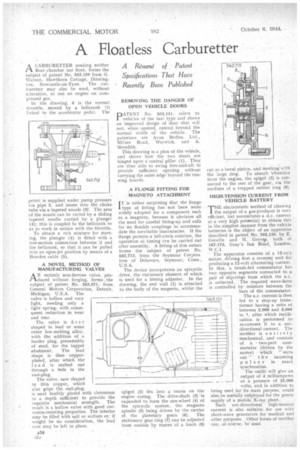A Floatless Carburetter
Page 36

If you've noticed an error in this article please click here to report it so we can fix it.
A Résumé of Patent Specifications That Have Recently Been Published
A CARBURETTER needing neither PI float chamber nor float, forms the subject of patent No. 563,159 from G. Watson, Hawthorn Cottage, Dinning. ton, Newcastle-on-Tyne. The carburetter may also be used, without alteration, to run an engine on compressed gas.
In the drawing, 6 is the normal throttle, moved by a bellcrank ft) linked to the accelerator pedal. The petrol is supplied under pump pressure via pipe 2, and issues into the choke tube via a tapered nozzle (3Y The area of the nozzle can be varied by a sliding tapered needle carried by a plunger (4); this is coupled io the bellcrank so as to work in unison with the throttle.
To obtain a rich mixture for starting, the plunger (4) is fitted with a lost-motion connection between it and the bellcrank, so that it can be pulled into an open-jet position by means of a Bowden cable (5)..
A NOVEL METHOD OF MANUFACTURING VALVES
AN entirely non-ferrous valve, produced without forging, forms the subject of patent No. 563,071. from General Motors Corporation, Detroit, Michigan, U.S.A. The
valve is hollow and very light, needing only a light spring, with consequent reduction in wear and tear.
The valve is first shaped in lead or some other low-melting alloy, with the addition of a harder plug, presumably of steel, for the tappet abutment. The lead shape is then copperplated, after which the lead is melted out through a hole in the end-plug.
The valve, now shaped in thin copper, which also grips the end-plug, is next heatiily plated with chromium to a depth sufficient to provide the requisite mechanical strength. The result is a hollow valve with good corrosion-resisting properties. The interior may be filled with salt or sodium or, if weight be no consideration, the lead core may be left in place.
A34 REMOVING THE DANGER OF OPEN VEHICLE DOORS
PATENT No. 563,151, refers to vehicles of the taxi type and shows an improved design of door that will not, when opened, extend beyond the normal width of the vehicle. The patentees arc Avon Bodies, Ltd., Millers Road, Warwick, and A. Meredith.
This drawing is a plan of the vehicle, and shows how the two doors are hinged upon a. central pillar (1). They, are thus able to swing fore-and-aft to provide sufficient opening without carrying the outer edge beyond the running boards.
A FLANGE FITTING FOR MAGNETO ATTACI-EVIENT
IT is rather surprising that the flange type of fitting has not been more widely adopted for a component such as a magneto, because it obviates all the need for careful lining-up and calls for no flexible couplings to accommodate the inevitable inaccuracies. If the flange permits a full-circle rotation, the operation of timing un be carried out after assembly. A fitting of this nature forms the subject of patent No_ 562,713, from the Seymour Corpora tion of Delaware, Seymour, Conn., U.S.A.
The device incorporates an epicyclic drive, the stationary element of which is used for a timing adjuster. In the drawing, the end wall (1) is attached to the body of the magneto, whilst the
spigot (2) fits into a recess on the engine casing. The drive-shaft (3) 'is expanded to form the sun-wheel (4) of the epicyclic system, the magneto spindle (5) being driven by the carrier of the planetary gears (6). The stationary gear ring (7) can be adjusted from outside by means of a knob (3)
cut as a bevel pinion, and meshing with the large ring. To absorb vibration from the engine, the spigot (2) is connected to the rest of the gear, via the medium of a trapped rubber ring (9).
HIGH-TENSION CURRENT FROM VEHICLE BATTERY
THE electrostatic method of cleaning the output of a gas-producer is very efficient, but necessitates a d.c. current at a very high potential; to obtain this in the simplest manner from the vehicle , batteries is the object of an apparatus described in patent No. 563,156, by E. Greville and H. Grovg, both of. 167-173, Gray's Inn Road, London, W.C.1
• The apparatus consists of a 12-vo:t motor, driving first a reverser unit for producing a 12-volt alternating current. In this, a brush-fed commutator has two opposite segments connected to a pair of slip-rings from which the a.e. is collected. The required wave-form is controlled by resistors between the bars of the commutator.
The ac. current is then fed to a step-up transformer having a ratio of between 2,000 and 3,000 to 1, after which rectification is performed -to re-convert it to a unidirectional current. The rectifier is entirely. .mechanical, and consists of a • two-part commutator (driven by the motor) which " sorts out " t Ii e incoming pulses in exact synchronism.
The outfit will give an output of 4 milliamperes at a pressure of 25,000 volts, and in addition to being used for its main purpose, could also,be usefully erriployed for the power supply of a mobile X-ray plant.
Such uni-directional high-tension current is also suitable for use with short-wave generators for medical and other purposes. Other forms of rectifier can, of course, be used




















































